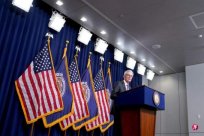
In order to control the inflation, the Federal Reserve has raised interest rates to the highest level since 2007.President Powell finally hinted at the beginning of the month that the goal of controlling inflation is about to be achieved, and the future rate of interest reduction can be expected. However, recent data shows that the problem of inflation in the United States is still lingering. Can the next inflation level be effectively relieved like the Fed expectations?It still needs further observation.
After the Fed has adjusted the federal benchmark interest rate to 5.25%to 5.5%since July last year, it has maintained at the highest level of the past 17 years and it has lasted more than half a year.Various signs show that the Fed will not move for a few months as much as possible because the economic data released this month will be semi -half, and the central bank cannot provide full reasons for the central bank to start paying interest rate reductions.
Powell said publicly at the beginning of the month that the goal of sustainable inflation can be maintained at 2%, and now it is more confident than before, and as the goal of confidence is "not far", it should be appropriately opened to relax the monetary policy.It will cause the economy to fall into decline.Shortly after his confidence shouted, the unemployment rate released by the US Department of Labor rose to 3.9%in February, which was 3.7%higher than the average prediction of Wall Street. The salary of last month was only 0.1%, which was lower than market expectations.Both data have been interpreted by the market as signs of slowing in the US economy. It is a favorable development for the control of anticipation of inflation.In addition, the Ministry of Labor has also significantly reduced the employment growth data of local December and January.At that time, the market was widely predicted that the Fed will start to reduce interest rates in the first half of the year.
However, the recently released consumer price index and manufacturer's price index, which has been released in February, unexpectedly stronger than the market average forecast, especially the latter, so that many economists have to doubt that the United States may face that the United States may face it. I am afraid that the United States is facing.It is a pretty stubborn inflation problem. It may not be relieved in the visible future. Whether the interest rate reduction will happen in the first half of the year may not be accurate.The consumer price index that measures the cost of commodity and service. Although the increase in last month is in line with market expectations, core inflation has increased due to energy costs, which is higher than market forecasts.As for the price index of manufacturers, which measures the cost of raw materials, intermediate products and finished pipelines, it rose 0.6%in February, which is twice the estimated Wall Street.
Looking at the latest inflation data, there are also disturbing places. The pace of slowing down the price of items seems to have stagnated, and the inflation in the service field seems to have a sign of rebounding again.Three months as of the end of February, the pace of 6.7%of the annualization rose was worrying.Overall, the consumer price index seems to fall to about 3%. It seems that it is not easy to further reduce the goals set by the Federal Reserve.Originally, it was generally optimistic that the Fed will cut interest rates two to three times this year. After the release of the latest data, the market is now inclined to pay interest rates twice during the year.
"Last Mile" test balance
It is no wonder that the Fed has reiterated prudent views and maintains a particularly patient attitude in the issue of interest rate reductions.Some Fed officials even said that they should wait until the third quarter to consider paying interest rates, not the first half of the market predicted.In describing the current Fed's work that fights inflation threats, the financial community is now used to the word "last mile".At this stage of stopping interest rate hikes to starting interest rates, it may be the most difficult process of the Fed's control of inflation. If it is not handled or lost, the previous anti -inflation efforts will be a loss.
The concerns about the "last miles" related to the success of the Fed's work and failure are not unparalleled.The International Monetary Fund warned last year that the central banks, including the Federal Reserve, had prematurely announced the exceptional examples of defeating inflation.Taking the United States as an example, Arthur Burns, who was the Federal Reserve Chairman in the early 1970s, was accused of relaxing prices at the time, so that inflation was out of control and evolved into a disaster that plagued the US economy for 10 years.It wasn't until Paul Volcker took over the Fed Chairman that he increased interest rates to the 20%highest level, and then ended the malignant inflation at that time, but he was unfortunately paid at the price of economic recession in the early 1980s.
However, some analysts pointed out that the inflation problem currently facing the Federal Reserve is very different from the terrible wages in the 1970s and the early 1980s.The current inflation is more due to the destruction of the supply chain, labor market and consumption expenditure due to the crown disease epidemic.In other words, the inflation problem this time is caused by the rising price of insufficient supply, rather than the rise in the price of excessive demand.
According to the idea of driving inflation in this supply, the tension of geopolitical environment naturally exacerbates the risk of inflation.An obvious source of problems is a conflict that is happening in the Middle East.The Hussean rebels attacked ships in the Red Sea due to fighting Hamas in the Red Sea, causing shipping to interrupt, so that the price of goods rose one after another, reflected in the latest inflation data in the United States.The longer such a tense situation lasts, the more difficult it is to ensure that the inflation data in the United States can further decrease, thereby achieving the target basis of interest rate reduction.As a result, before considering the interest rate, the Fed must not take care of this major factor that may cause inflation to be higher than expected.
Of course, Powell's confidence at the beginning of the month is not completely without confidence.The Fed's confidence is attributed to the nature of American inflation and the speed of decline.Although the United States was severely hit by crown -related supply chains, it did not experience the extent that prices were significantly increased to two -digit number after the invasion of Ukraine in Russia, like Europe, as it was in Russia.After the inflation rate in the United States reached a peak of 9.1%in 2022, it continued to go downhill and never reached double digits, and the target of 2%today is not far away.
But at the current "last mile" stage, the Fed faces the situation where the inflation and price of supply -driven inflation and prices are stubborn coexisting.Decisions to ensure that soft landing will not be harmed due to the tightening of the monetary policy for too long or early relaxation.This task will be quite arduous for the Federal Reserve.
The author is a local current affairs commentator




